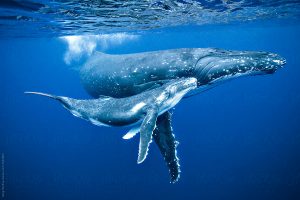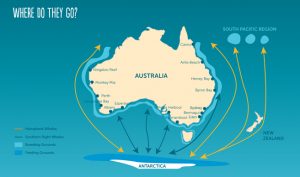Each year between April and November, Australia’s eastern coastline comes alive with the spectacular acrobatic displays of humpback whales. After a summer of feeding on krill in Antarctic waters, these charismatic animals migrate north to sub-tropical waters where they mate and give birth. And we are lucky enough to be able to easily spot them on their travels from our majestic coastline! Read on for more fascinating information about the migration and for FREE Humpback Whale Resources.
Why not book a Humpback Whale themed incursion or check out our Humpback Whale Teaching Resource Pack.
During their annual migration of up to 10 000 kilometres, humpbacks can easily be seen off the coast of New South Wales and Queensland.
The exact timing of the migration period can vary from year to year depending on water temperature, sea ice, predation risk, prey abundance and the location of their feeding ground.
Humpback Migration Route and Timing
The majority of humpbacks in Australian waters migrate north from June to August, and back towards the Southern Ocean from September to November.
Migration Grouping
Groups of young males typically lead the migration while pregnant cows and cow-calf pairs bring up the rear. Adult breeding animals form the bulk of the migration in the middle stages.
Humpback Whale Facts
- Humpback whale length: 12- 16 metres
- Humpback whale weight: up to 50 tonnes or 6 elephants!
- Average birth weight of humpback: 2 tonnes
- Birth length: 4-5 metres
- Humpback whale gestation period: 11 months
- Favoured birth temperature: 22-25 degrees
- Origin of Humpback Whale name: the name comes from their very long pectoral fins and knobby looking head which looks a bit like a hump!
- Easily tracked as identifiable by the unique markings on their tail fluke – so we can learn lots about them!
- Humpback whale travel speed: up to 8 km an hour
- Migration travel speed: humpback average only 1.6km an hour during the migration as they rest and socialise along the way
- Humpbacks sing songs that may be heard hundreds of kilometres away
- East Coast Australia’s most famous humpback whale is white and has an Aboriginal name, ‘Migaloo’ which means white fella.
The humpback whale is not the largest whale found in Australian waters but we reckon its’ the most iconic.



